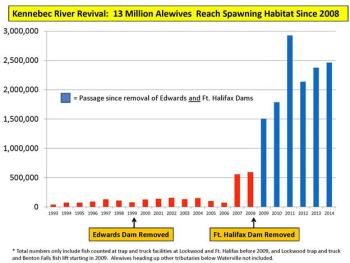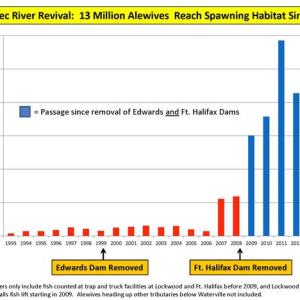From Augusta: Post-Edwards Dam removal, State Library launches wireless printing, union praises Mazurek, and more
 Many adult and immature Bald Eagles now congregate along the Sebasticook River, due to abundant supplies of food, especially alewives, since the Edwards and Fort Halifax Dams were removed. This year, Maine Department of Inland Fisheries and Wildlife officials counted 58 Bald Eagles on a single day (June 6) along the five-mile stretch of the Sebasticook River leading from the Kennebec to the Benton Falls fish lift. This likely is the largest congregation of Bald Eagles in the Northeast, and possibly anywhere north of the Chesapeake Bay. Photo credit: Sharon Fieldler
Many adult and immature Bald Eagles now congregate along the Sebasticook River, due to abundant supplies of food, especially alewives, since the Edwards and Fort Halifax Dams were removed. This year, Maine Department of Inland Fisheries and Wildlife officials counted 58 Bald Eagles on a single day (June 6) along the five-mile stretch of the Sebasticook River leading from the Kennebec to the Benton Falls fish lift. This likely is the largest congregation of Bald Eagles in the Northeast, and possibly anywhere north of the Chesapeake Bay. Photo credit: Sharon Fieldler

 Many adult and immature Bald Eagles now congregate along the Sebasticook River, due to abundant supplies of food, especially alewives, since the Edwards and Fort Halifax Dams were removed. This year, Maine Department of Inland Fisheries and Wildlife officials counted 58 Bald Eagles on a single day (June 6) along the five-mile stretch of the Sebasticook River leading from the Kennebec to the Benton Falls fish lift. This likely is the largest congregation of Bald Eagles in the Northeast, and possibly anywhere north of the Chesapeake Bay. Photo credit: Sharon Fieldler
Many adult and immature Bald Eagles now congregate along the Sebasticook River, due to abundant supplies of food, especially alewives, since the Edwards and Fort Halifax Dams were removed. This year, Maine Department of Inland Fisheries and Wildlife officials counted 58 Bald Eagles on a single day (June 6) along the five-mile stretch of the Sebasticook River leading from the Kennebec to the Benton Falls fish lift. This likely is the largest congregation of Bald Eagles in the Northeast, and possibly anywhere north of the Chesapeake Bay. Photo credit: Sharon Fieldler

After the removal of Edwards Dam....
AUGUSTA — This year, officials with the Department of Inland Fisheries and Wildlife counted 58 Bald Eagles on a single day (June 6) along the five-mile stretch of the Sebasticook River leading from the Kennebec to the Benton Falls fish lift. This likely is the largest congregation of Bald Eagles in the northeast, and possibly anywhere north of the Chesapeake Bay. Maine now has more than 630 nesting pairs of Bald Eagles, up from about 20 nesting pairs in 1967. The increased numbers of river herring have provide an important food source for the eagles, contributing to their recovery.
Fifteen years ago, the removal of the 160-year-old Edwards Dam restored a free-flowing Kennebec River. Excavators breached the dam on July 1, 1999, with thousands of people watching the event from the banks of the river in Augusta. Removal of the 917-foot-long dam, built in 1837, came about because, for the first time, the Federal Energy Regulatory Commission (FERC) ruled that the ecological value of a free-flowing river was greater than the economic value of a dam. FERC actually ordered the dam removed. On July 17, 2008 dam owner FPL Energy Maine Hydro breached the Fort Halifax Dam after deciding that removal made more sense economically than investing in the type of fish lift that would have been required. Prior to the Fort Halifax removal, DMR captured alewives using a vacuum pump and trucked them to upstream lakes.
Benefits to the river and fisheries began almost immediately following each of these dam removals. Today, the Kennebec has come back to life. It has become a draw for local residents and businesses. Boaters, anglers, and birdwatchers are regular visitors to the restored Kennebec, as well as its walking trails, riverfront docks, parks, and boat launches.
"For more than 160 years, fish coming up the Kennebec could not get past the Edwards Dam, where they were dozens of miles away from their prime spawning habitat," said NRCM Executive Director Lisa Pohlmann, in a news release. "But now alewives and other fish can swim from the sea to freshwater lakes in the Sebasticook watershed, and the results have been astounding. While there's still important work to do to further improve the fisheries of the river, we now know that nature will restore itself dramatically if we give it a chance."
The breaching of these dams has contributed many additional benefits to communities in the watershed. In Augusta, the former location of the Edwards Dam and its associated mill now are the site of Mill Park, which is an attractive destination because of its canoe and kayak launch, pavilion, and weekly farmers market. The Town of Benton receives about $20,000 per year from its annual alewife harvest below the Benton Falls dam and this year hosted its third annual Alewife Festival. The festival features a range of community events, including an alewife-themed dinner, alewife chowder contest, demonstrations on how to smoke alewives with 200-year-old techniques, and a "fun run."
"The recovery of sea-run fish has been astounding. We have a strong recreational shad fishery, a huge alewife run that supports two town-managed commercial alewife harvests above the former Edwards site, and promising results from an experimental salmon egg planting project for Atlantic salmon. The change since 1999 is dramatic," said Jeff Reardon of Trout Unlimited.
"River herring are critical to Atlantic salmon," says John Burrows of the Atlantic Salmon Federation. "When river herring are plentiful, predators like cormorants and seals often prey on them instead of migrating Atlantic salmon. We remain hopeful that continued progress for river herring in the Kennebec watershed can contribute to Atlantic salmon restoration."
The removal of Edwards Dam was the result of a decade-long effort of the Kennebec Coalition, which included American Rivers, the Atlantic Salmon Federation, the Natural Resources Council of Maine, and Trout Unlimited and its Kennebec Valley Chapter. It involved an innovative agreement among FERC, federal and state natural resource agencies, the City of Augusta, the State of Maine, and dam owners. NRCM, ASF and TU were the lead groups involved in seven years of legislative and legal efforts that preceded removal of the Fort Halifax Dam.
State Library launches wireless printing for laptops, mobile devices
AUGUSTA — Wireless printing from laptops, IPads and even cellphones is now an option for patrons at the Maine State Library in Augusta, thanks to some recent technology upgrades. Starting this week, mobile device users can access library printers by sending their files by email, using a web portal or downloading an app to their phone or tablet. The cost for printing is $.15 per page and print jobs must be retrieved within two hours.
The move comes as a growing share of the population shifts to mobile devices as their primary access to the internet. According to the PewResearch Internet Project, 63 percent of adult cell owners use their phones to access the internet, and for nearly a third of that population, their mobile device is their primary source for access to information online.
Maine Military Authority gets $19 million to overhaul buses
The Massachusetts Bay Transit Authority Board of Directors this week approved the award of a contract to the Maine Military Authority in Limestone for the midlife overhaul of 32 Dual Mode Articulated NEOPLAN Buses. The $19 million award to MMA marks the culmination of years of strategic and deliberate planning to gain access to new markets as military budgets decline. The contract could likely increase to $24 million as optional and additional tasks are requested.
In 2012 MMA completed a major renovation of its facilities specifically designed to support large and over-sized vehicles. Since 2012, MMA has successfully developed an end-of-life rebuild program for Para-Transit (shuttle) buses and a mid-life overhaul for mass transit buses.
According to MMA spokesman Tim McCabe: "The rehabilitation of these buses will increase its service life expectancy by an additional 6 years beyond it intended life of 12 years. Our process is extremely thorough and painstaking. These buses will be rehabilitated with the same dedication and workmanship as we have for all the military vehicles we have produced for our National Guard Soldiers."
The DMA bus is a "dual mode" bus. It is powered by a diesel engine for part of its route and a traditional electric-powered trolley for part of its route. It is a one-of-a-kind dual bus/trolley and one of the most complex systems in North America. MMA has teamed with SKODA Electric, the original equipment manufacturer of the electric propulsion system, to form a team capable of this demanding project.
The mass transit overhaul/rebuild market is growing.
Revised Statewide Mutual Aid Agreement now online
AUGUSTA — In 2009, An Act Authorizing Statewide Mutual Aid Among First Responder Agencies allowed local first responder agencies to provide emergency services such as fire, law enforcement, emergency management or medical services as necessary upon another town's request without any additional agreement or contract. Five years later, several changes have been made to the original agreement and supporting statutes:
All towns are part of the agreement but may adopt a local ordinance to opt out; no community to date has opted out. Anyone directed by MEMA or local EMA agencies to work in an emergency are considered to be state employees. In the past, only MEMA could authorize people to work as state employees during an emergency. Under the International Emergency Mutual Assistance Compact (IEMAC), an agreement with the eastern Canadian Provinces, agencies can also authorize people to work in Canada. The IEMAC and the National Forest Fire Protection Compact (NFFPC) have been added into the lists of agreements under which the Governor can request or offer assistance during an emergency. Several changes have also been made to the NIMS/ICS training guidance to better prepare leaders during emergencies.
The updated Statewide Mutual Aid Agreement.
Primary Care Practices in the Let's Go! Program to Receive 10,000 Maine State Park Passes for Patients Courtesy of State Bureau of Parks and Land and Harvard Pilgrim Health Care Foundation
Primary care physicians at 124 practices across Maine who participate in the Let's Go! program will be able to provide their patients and families with more than 10,000 free Maine State Parks passes courtesy of the Maine Department of Agriculture, Conservation and Forestry's Bureau of Parks and Lands, Let's Go! and the Harvard Pilgrim Health Care Foundation. The free pass is good at any of Maine's 48 state parks and historic sites, with the exception of Baxter State Park, and valid through December.
Participating physician practices will receive their free passes starting July 7.
Let's Go!'s 5-2-1-0 daily message encourages healthy eating and increased physical activity for the whole family:
5 or more fruits or vegetables
2 hours or less recreational screen time
1 hour or more of physical activity
0 sugary drinks, more water, and low-fat milk
"We want to help prevent childhood obesity by creating healthy opportunities for children and their family to stay active," says Karen Voci, president of the Harvard Pilgrim Health Care Foundation, which funds programs that prevent and combat childhood obesity by changing the environments where kids play and learn "Through the Foundation's support, Let's Go! is encouraging doctors to promote the 5-2-1-0 messaging with their patients, and focus on ways to build a lifetime of wellness. These free park passes make it affordable for families to enjoy the great outdoors and embrace an active and healthy way of life."
This is the third year that parks passes have been made available to Let's Go! pediatricians.
Visit www.letsgo.org to learn more about the Let's Go! program.
For more information on Maine state parks and historic sites, go to: http://www.parksandlands.com
|
Event Date
Address
United States


























